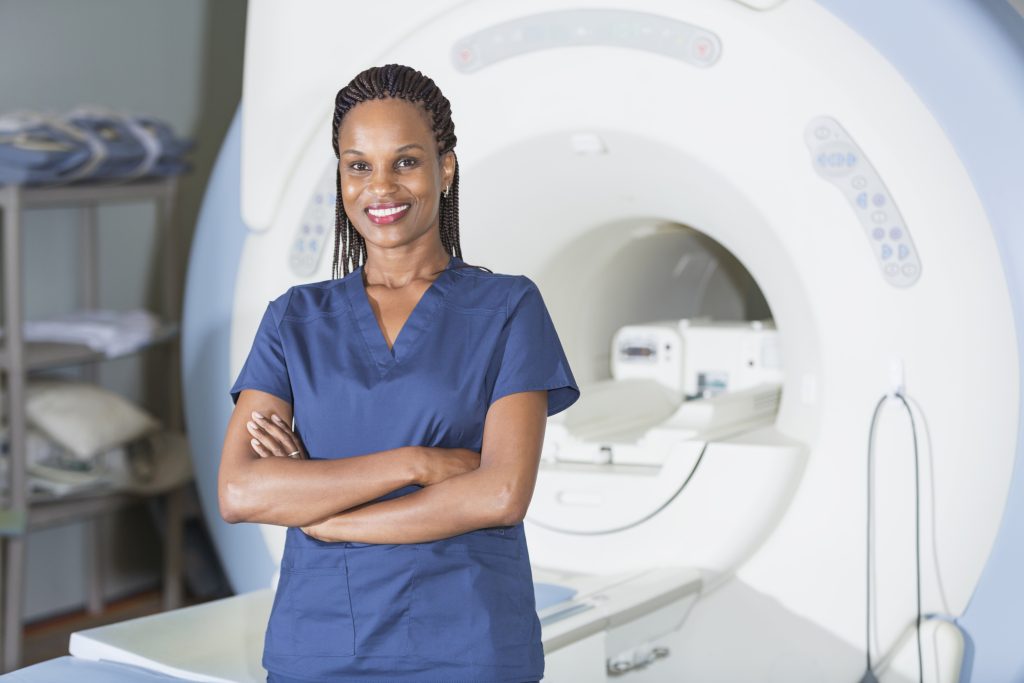What Is the Difference Between a Diagnostic Medical Sonographer and an MRI Tech?
Published - December 28, 2023


Table of Contents

What Does a Sonographer Do?
Diagnostic medical sonographers, often called “sonographers,” harness ultrasound technology to create images of internal body structures. Doctors use the pictures to monitor fetal development, evaluate soft tissue injuries, and assess how organ systems are working.
Ultrasound is the test of choice for examining abdominal organs, the heart, and the female reproductive system. Like X-ray technology, it’s a safe and non-invasive procedure. But ultrasound better visualizes soft tissue and produces no radiation, making it a safer option for pregnant women or conditions requiring repeat testing.
Diagnostic sonographers work in hospitals, clinics, and private practices, managing the entire imaging process from beginning to end.
Their responsibilities include:
- Patient preparation, positioning, and hospitality.
- Creating a clean, comfortable, and private testing environment.
- Using ultrasound machines to conduct abdominal, gynecological, cardiac, and other sonograms.
- Assisting doctors with guided ultrasound exams.
- Adjusting machine settings to optimize image quality and diagnostic value.
- Equipment care, including maintenance, calibration, and troubleshooting.
- Environmental safety, including infection control and sanitation measures.
- Stocking workstation supplies from ultrasound gel to skin cleansers.
- Recordkeeping, including noting examination details and recording ultrasound images in patient charts for future reference.
- Providing preliminary image interpretation to help guide medical decision-making.
- Serving as a resource for other healthcare providers with questions about ultrasound technology.
- Patient education, including providing aftercare instructions.
What Does an MRI Tech Do?
Magnetic Resonance Imaging (MRI) is a non-invasive imaging technique that uses magnets and radio waves to create detailed, cross-sectional images of internal body structures based on the cellular response to hydrogen. Because sound waves travel poorly through bone and complex structures, MRIs are the preferred way to obtain deep, high-resolution brain, spine, and joint images.
Like ultrasound, MRI technology is radiation-free. However, it’s not entirely without risk for certain patients, and precautions are required.
The work encompasses:
- Operating MRI machines.
- Adjusting image sequences, resolution, and contrast to obtain the best possible diagnostic images.
- Maintain, calibrate, and test MRI equipment.
- Screening patients for contraindications, such as claustrophobia and implanted devices made of metal.
- Ensuring patient comfort — optimal positioning is critical for this lengthy test.
- Explaining the MRI procedure, including instructions to remain still.
- Providing hearing protection — MRIs can exceed 100 decibels.
- Patient monitoring, especially for sedated patients.
- Environmental safety — ensuring the treatment suite is free of safety hazards, such as magnetic objects.
- Documentation — ensuring that MRI images are correctly labeled, sent to the ordering provider, and filed in the appropriate chart.
- Emergency response — dealing with patients who may have an adverse reaction to the MRI process, such as pain or panic attacks.
- Professional collaboration with physicians, nurses, radiologists, and other members of the healthcare team.
What Is the Difference Between a Diagnostic Medical Sonographer and an MRI Tech?
Diagnostic medical sonographers and MRI technicians have similar missions but different roles.
Your chosen career should reflect your strengths, interests, and career goals — it’s a big decision.
Differences to consider include:
Training and Education
Training for diagnostic sonographers and MRI technicians is highly specialized. Students focus on only one imaging modality.
Programs are similar, covering universal topics such as anatomy, physiology, patient care, communication, and the general science of medical imaging. However, the MRI tech curriculum is more math-heavy than the sonography program due to the inherent complexity of the technology.
Licensing and Certification
Neither diagnostic sonographers nor MRI technicians are currently licensed. Certification, however, is strongly encouraged. It builds self-confidence and demonstrates the skills and commitment employers are looking for.
The most widely recognized certification for medical sonographers is the Certified Diagnostic Medical Sonographer (RDMS) credential offered by the American Registry for Diagnostic Medical Sonography (ARDMS). Your level of training determines eligibility.
MRI technicians can obtain certification through the American Registry of Magnetic Resonance Imaging Technologists (ARMRIT) or the American Registry of Radiologic Technologists (ARRT).
Work Environment
MRI technicians work almost exclusively in hospitals and imaging centers. Clinics and doctor’s offices rarely offer such costly technology.
Sonography is a long-established science available in various inpatient and outpatient settings, including hospitals, clinics, and private practices. In rural areas, diagnostic sonographers may have more jobs to choose from.
Schedule
Jobs in hospitals may include night, weekend, and holiday shifts. MRI and ultrasound technicians are needed around the clock.
Sonographers, however, have more opportunities for a regular Monday through Friday schedule because they can work in non-acute care settings. A specialty clinic or private practice position may offer a better work-life balance for people with a busy home life or other obligations.
Patient Interaction
Sonographers and MRI technicians interact with patients regularly. Once testing begins, however, MRI technicians retreat to a safe room. You’ll talk with patients over a speaker but have minimal face-to-face contact.
Diagnostic sonographers work more closely with patients, verbally and sometimes physically, guiding the frequent position changes necessary to capture good-quality images. And because patients can see the images, they often have questions. You’ll need to be an enthusiastic people-person.
Physical Demands
MRI techs position patients for testing, but the machine does the rest. The job involves standing, bending, twisting, and reaching, but you’ll be sitting extensively while the test is performed.
Sonographers apply a transducer to the evaluated body area, requiring more upper-body flexibility and longer standing tolerance. You’ll be on your feet for more extended periods.
Occupational Safety Considerations
Diagnostic sonography and MRI are safe careers. But as with all jobs, each poses long-term occupational risks. MRI machines, for example, are loud and can cause hearing damage without adequate ear protection. And because they generate extreme magnetic fields, ferromagnetic materials in the vicinity can become projectiles unless adequately secured. Safety protocols keep staff well-protected, but awareness, diligence, and self-care are critical.
Sonography is a lower-risk career with fewer potential hazards. Machines produce no radiation, magnetism, or audible sound. Repetitive use injuries involving the arm, hand, or shoulder, however, are not uncommon with the everyday use of a handheld transducer. Proper ergonomics are vital to staying healthy.
Career Development
The next step in career development for an MRI technician involves specialization, education, or cross-training. With a vocational diploma and experience, you can pursue cardiac, breast, or neuroimaging roles. Or earn while you learn, studying for a bachelor’s degree to qualify for leadership or teaching positions.
Career development opportunities for diagnostic medical sonographers follow a similar track. The American Registry for Diagnostic Medical Sonography (ARDMS) offers a variety of specialty certifications. Or you can build on your diploma by getting a degree in sonography or a related discipline.
Cross-training in other imaging modalities may be more practical for MRI technicians than sonographers because of their broader math and physics training. Having those credits on your academic resume can make getting into a degree program easier.
How do You Become a Sonographer or MRI Tech?
If you’re interested in a medical imaging career, the good news is that the training requirements are modest. Unlike careers that take years in college to train for, you can become a diagnostic medical sonographer or an MRI technician by completing an accessible and lifestyle-friendly vocational school program. You’ll graduate in months, prepared for an entry-level role with far-reaching benefits.
Final Thoughts
Healthcare is a growing industry that needs skilled imaging technicians. So, why not enjoy a future-forward career that contributes to the health and wellness of your friends, neighbors, and community? All you need to get started is the willingness to learn and the right vocational program.
Diagnostic Medical Sonographer Program
If you enjoy working side-by-side with physicians and radiologists and like a good challenge, this is your career! There is a high demand for Ultrasound Technicians in the US and abroad, so this job gives flexibility during your career.
In as little as 20 months, CBD College’s Diagnostic Medical Sonography Associate Degree Program will prepare you for what it takes to be a Diagnostic Medical Sonographer/Ultrasound Technician.
MRI Technician Program
If you enjoy the idea of working side-by-side with physicians and radiologists and enjoy a good challenge in a technologically advanced field, this is your career choice!
In as little as 18 months, the AAS in MRI Program that follows the ARRT Primary Pathway will prepare you with the knowledge and skills you will need to fulfill the responsibilities of a Magnetic Resonance Imaging Technologist.
Contact us now to learn more.